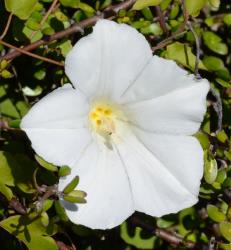- Taxon
- Gallery
- ≡ Convolvulus tuguriorum G.Forst. in Forster, Fl. Ins. Austr. 14 (1786)
- = Convolvulus truncatella Colenso, Trans. & Proc. New Zealand Inst. 21: 95 (1889)
Rhizomatous perennial with slender, much-branched, glabrous or puberulent, climbing stems. Petioles to c. 4 cm long, slender. Lamina (1)–2–4–(5) × (1.5)–2–3–(4) cm, broad-ovate to deltoid or reniform, entire or sinuate; base cordate, usually with shallow, broad sinus; apex acute to acuminate. Peduncles (3)–4–11 cm long, generally > lvs, terete or slightly winged. Bracts broadly ovate to suborbicular; base cordate; apex apiculate. Sepals similar to and < to somewhat > bracts. Corolla (2.5)–3–5 × (3)–4–6 cm diam., funnelform, usually white, sometimes pink. Ovary imperfectly 2-locular. Capsule 8–12 mm long, excluding apiculus, broad-ovoid. Seeds orange, smooth.
[From: Webb et al. (1988) Flora of New Zealand. Volume 4.]
Flowering: Sep.–Mar.




